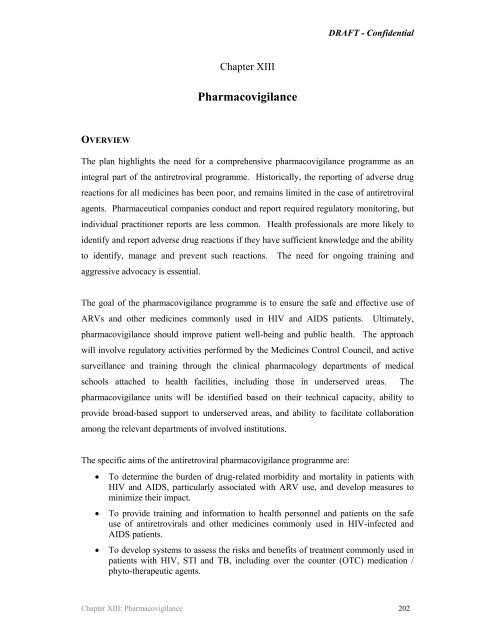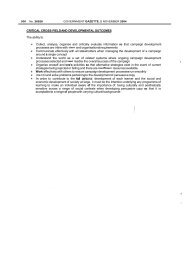Operational plan for comprehensive HIV and AIDS care and ...
Operational plan for comprehensive HIV and AIDS care and ...
Operational plan for comprehensive HIV and AIDS care and ...
You also want an ePaper? Increase the reach of your titles
YUMPU automatically turns print PDFs into web optimized ePapers that Google loves.
DRAFT - Confidential<br />
Chapter XIII<br />
Pharmacovigilance<br />
OVERVIEW<br />
The <strong>plan</strong> highlights the need <strong>for</strong> a <strong>comprehensive</strong> pharmacovigilance programme as an<br />
integral part of the antiretroviral programme. Historically, the reporting of adverse drug<br />
reactions <strong>for</strong> all medicines has been poor, <strong>and</strong> remains limited in the case of antiretroviral<br />
agents. Pharmaceutical companies conduct <strong>and</strong> report required regulatory monitoring, but<br />
individual practitioner reports are less common. Health professionals are more likely to<br />
identify <strong>and</strong> report adverse drug reactions if they have sufficient knowledge <strong>and</strong> the ability<br />
to identify, manage <strong>and</strong> prevent such reactions. The need <strong>for</strong> ongoing training <strong>and</strong><br />
aggressive advocacy is essential.<br />
The goal of the pharmacovigilance programme is to ensure the safe <strong>and</strong> effective use of<br />
ARVs <strong>and</strong> other medicines commonly used in <strong>HIV</strong> <strong>and</strong> <strong>AIDS</strong> patients. Ultimately,<br />
pharmacovigilance should improve patient well-being <strong>and</strong> public health. The approach<br />
will involve regulatory activities per<strong>for</strong>med by the Medicines Control Council, <strong>and</strong> active<br />
surveillance <strong>and</strong> training through the clinical pharmacology departments of medical<br />
schools attached to health facilities, including those in underserved areas. The<br />
pharmacovigilance units will be identified based on their technical capacity, ability to<br />
provide broad-based support to underserved areas, <strong>and</strong> ability to facilitate collaboration<br />
among the relevant departments of involved institutions.<br />
The specific aims of the antiretroviral pharmacovigilance programme are:<br />
• To determine the burden of drug-related morbidity <strong>and</strong> mortality in patients with<br />
<strong>HIV</strong> <strong>and</strong> <strong>AIDS</strong>, particularly associated with ARV use, <strong>and</strong> develop measures to<br />
minimize their impact.<br />
• To provide training <strong>and</strong> in<strong>for</strong>mation to health personnel <strong>and</strong> patients on the safe<br />
use of antiretrovirals <strong>and</strong> other medicines commonly used in <strong>HIV</strong>-infected <strong>and</strong><br />
<strong>AIDS</strong> patients.<br />
• To develop systems to assess the risks <strong>and</strong> benefits of treatment commonly used in<br />
patients with <strong>HIV</strong>, STI <strong>and</strong> TB, including over the counter (OTC) medication /<br />
phyto-therapeutic agents.<br />
Chapter XIII: Pharmacovigilance 202
















